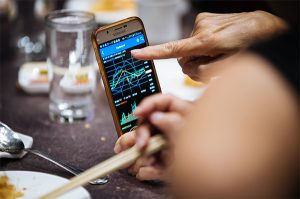Date: August 19, 2019

- STI lost 54 points or 1.7% over the week at 3,115.03;
- US-China trade and US yield curve inversion were main reasons;
- Some respite after US said it would delay tariffs until Dec;
- Also helping was China signalling possible stimulus;
- July’s NODX fell less than expected;
- Yanzijiang’s shares crash on news of probe
STI falls victim to recession worries
Regular readers of this report would know that we have on a few occasions in the past few months warned of the impending inversion of the US Treasury yield curve where short-term rates exceed long-term rates, a phenomenon often taken to be a precursor to a recession.
After threatening to do many times in the past 6 months, the US yield curve last Wednesday inverted for a brief period on Wednesday, bringing the sellers out in force.
Although Friday’s session saw slightly less pressure on equities after China’s authorities signalled they are prepared to provide stimulus for their flagging economy, the Straits Times Index nevertheless lost almost 54 points or 1.7% over the week at 3,115.03. The index is now -5.6% for August.
Trade concerns continue
Another week, another bout of US-China trade war worries. Other than the yield curve, the story of last week’s market movements was the same as it’s been for the past month, though this time the possible direction of US interest rates was relegated to the back-burner – at least until the next Federal Reserve meeting in September.
The week started with news that US President Trump had levied a fresh 10% tariff on US$300b worth of Chinese goods and that this would kick in from 1 Sep onwards. Predictably this led to widespread selling of stocks and a flight to safety, mainly US Treasuries.
This then pushed bond yields even lower, and despite some respite coming on Tuesday after the US said it would delay the new tariffs until December to help Christmas shoppers, turmoil in the US bond market on Wednesday brought the sellers out in force.
For a very short while, the yield curve inverted
For the first time since the financial crisis, the benchmark 10-year Treasury yielded less than the two-year note on Wednesday, a pricing anomaly known as a “yield curve inversion,” and is seen as an indicator of recession.
The 10-year Treasury plunged 8.2 basis points to 1.596%, its lowest since September 2016 whilst the 2-year note rate retreated 7.5 basis points to 1.592%. The 30-year note in the meantime tumbled 9.3 basis points to 2.038%, an all-time closing low.
During the session the gap between the 10-year and 2-year yield narrowed to -1%, thus temporarily producing an inverted yield curve.
“At the moment, investors think bonds are the safest way to protect their portfolio. And some think there’s another shoe to drop and a bigger correction in equities must be waiting around the corner,” Robert Robis, chief fixed income strategist at BCA Research, told MarketWatch.
Traders attributed the Wednesday selloff in equities and buying of bonds to a raft of negative economic data, most notably from China and Germany.
The slowdown in China’s economy was highlighted by a rise in industrial production at its slowest pace since Jan 2002, increasing 4.8% in July from a year earlier versus a 6.3% increase in June.
Germany’s economy shrank 0.1% in the second quarter of 2019 as the U.S – China trade war hit global manufacturing supply lines and the country’s export-dependent industries.
What next on the trade front?
In a commentary in the New York Times on 3 Aug titled “Trump’s Trade Quagmire (Wonkish)’’ Nobel prize-winning economist Paul Krugman said the US President’s trade approach with China is not working and described the present situation as a “quagmire’’, which is “what happens when a government has committed itself to a policy that isn’t working, but can’t bring itself to admit failure and cut its losses. So it just keeps escalating, and things keep getting worse’’.
Mr Krugman also said the conflict is now having a significant drag on the US economy and tried to predict what might happen next. “My guess is that instead of rethinking, he’ll escalate, which he can do on several fronts. He can push those China tariffs even higher. He can try to deal with trade diversion by expanding the trade war to include more countries’’.
“And he can sell dollars on foreign exchange markets, in an attempt to depreciate our currency. The Fed would actually carry out the intervention, but currency policy is normally up to the Treasury Department, and in June Jerome Powell reiterated that this is still the Fed’s view. So we might well see a unilateral decision by Trump to attempt to weaken the dollar’’.
July’s NODX fall was slower than expected
On Friday the government announced that Singapore’s non-oil domestic exports (NODX) fell 11.2% last month, versus 15.4 % that economists had predicted. NODX fell 17.4% in June.
Yanzijiang’s shares collapse after news that chairman is assisting in a probe
Shares of China shipbuilder were in focus on Thursday after a trading halt was lifted and the company announced that its executive chairman Ren Yuanlin has taken leave to focus on “assisting in a confidential investigation carried out by certain PRC government authorities’’.
It is believed the investigation involves another individual, Liu Jianguo who is closely connected to Mr Ren. The stock crashed 17% on Thursday or 18 cents to $0.86, a 30-month low.
Hyflux to engage exclusively with Utico
Troubled water treatment firm Hylux said on Friday that it intends to enter into exclusive talks with Utico from now until Aug 26, the deadline set by Utico for a firm deal. Utico had earlier agreed to take an 88% stake in Hyflux through a $300m cash injection and $100m shareholder loan and is engaging Hyflux’s creditors to work out details of a rescue plan.





